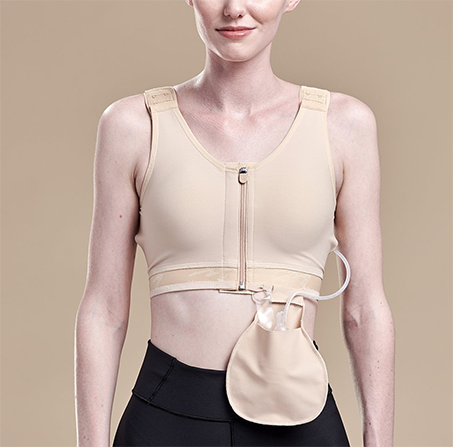Mastectomy Drains and Care: What You Should Know
Jan 15th, 2024

One of the biggest complaints patients have after mastectomy surgery is caring for their drains. Drains are placed inside wounds at the surgical site to remove blood and lymph fluid and prevent postoperative complications.
The tubing, pouches, and bulbs can be cumbersome and challenging to care for. Depending on your surgery, whether unilateral or bilateral, you can expect between one and five drains for up to three weeks.
Mastectomy drain care following breast surgery is critical to avoid infections that can compromise your surgery and strain an already fragile immune system. Discover how to take care of your drains quickly and easily after mastectomy surgery and when you need to call a healthcare provider for a checkup and drain removal.
A Closer Look at Mastectomy Drains
Following a mastectomy, your body’s response is to send lymph fluid to the area to help with healing. Lymph fluid is packed with white blood cells to repair your surgical incision, but sometimes, your body goes into overdrive, causing too much fluid to accumulate. Mastectomy drains are essential for removing excess fluid and preventing bacterial buildup that can lead to infections.
The Jackson-Pratt drain system is one of the most common types of drainage used after a mastectomy. These drains use small tubes the surgeon places in or near the surgical site during the operation. They exit your body through tiny incisions, separate from the main surgery incision. At the end of each tube is a little bulb or container. This part acts like a mini vacuum. It gently sucks the fluid out and collects it so it doesn’t build up in your body.
The fluid collected in the bulb is usually a mix of blood and lymph, and you or your caregiver will need to empty the bulbs and measure the fluid regularly. This helps track how much fluid is collected and ensures the drains work properly.
Your surgeon may also use other types of drains, like the Blake drain or the Hemovac drain. The Blake drain features a silicone tube with channels along its sides, allowing fluid to be drawn away from the surgical site into a collection bulb.
The Hemovac drain is a closed system with a spring-like vacuum inside a round, flat container. It creates constant suction, pulling fluids from the surgical area into the container.
The Importance of Proper Drain Care
Although your drainage system is essential for promoting a faster recovery and preventing complications after surgery, keeping the drains clean and clear is equally critical. Some reasons why you need to perform careful post-mastectomy drain care include:
- Keep Bacteria Out. Surgical drains create a pathway from the inside of your body to the outside, which can be an open invitation for bacteria if not cared for properly. Regularly cleaning the drains and where they exit your body is vital to prevent infections.
- Ensure Drains Work Properly. You need to make sure the drains aren’t blocked and are emptied as needed. If fluid builds up, it can become a breeding ground for bacteria, increasing the risk of infection.
- Manage Fluid Buildup. Proper care of your drains helps to continuously remove excess fluids like blood and lymph from the surgical area. This reduces swelling and allows the tissues to heal more effectively.
- Monitor Your Healing. Regularly emptying the drains and keeping track of the fluid amount gives you and your doctor a good idea of how your healing is progressing. A gradual decrease in fluid and a change in color from pink to light yellow is a positive sign of recovery.
- Comfort and Mobility. Well-maintained drains are less likely to cause discomfort or limit your movement. This makes your recovery more comfortable and can also help you stay active, which is important for regaining your strength.

Steps for Drain Care After a Mastectomy
Before you leave the clinic or hospital, your healthcare team will give you specific instructions on how to milk your drain, measure the fluid, and keep the drain system clean and properly functioning. Some of the advice they may give you includes:
- Wash Your Hands. Before touching the drainage system and after milking the tubes and emptying the bulb, wash your hands with warm water and soap for at least 20 seconds.
- Milk the Tube. You need to milk or strip the drainage tubes to ensure that all the fluid buildup is collected in the drain bulb. Hold the end of the tube closest to your body and slide two fingers along the tube down toward the bulb.
- Empty the Drain. Depending on your instructions and the amount of fluid collected, you’ll need to empty the drain collection bulb between two and four times per day. Typically, you need to empty it when the bulb is filled halfway.
Open the stopper and pour the content into a measuring cup to empty it. Do not remove the bulb from the tubing, and ensure you squeeze the bulb while replacing the stopper to start the suction again. - Measure and Monitor the Drain Output. Check the amount and color of the fluid emptied from the drain and write it down in a log. Early in your recovery, you should see around 100 cc of fluid, which will be pinkish. As you heal, the amount will lower, and the color should change to a light yellow. Your doctor can remove the drains once you produce only around 30 cc of fluid.
- Clean the Drain Insertion Site. Wash the area around the drain tubing with soap and warm water, but do not scrub. Pat dry with a clean towel and change towels each time.
- Secure Your Drains. Drain tubing can extend between 14” and 18” and easily become tangled, which can pull on the incisions and cause discomfort. Wearing a specialized camisole or bra with an integrated drain management system like the Amoena Hannah Mastectomy Bra Kit can help you keep your drains secure.

Identifying Common Issues with Mastectomy Drains
After a mastectomy, knowing how to identify and address common issues with surgical drains can impact your recovery process. Typical problems you might encounter:
- Blockages in the Drain. If the drain is not collecting fluid as it should, or you notice a decrease in the output despite increased swelling or pain around the surgical site, this may be due to a blocked drain tube. Gently milk the tube to move clots or debris along the tube. If this doesn’t resolve the issue, contact your healthcare provider.
- Signs of Infection. Redness, warmth, swelling, or pain around the drain site; foul-smelling, cloudy, thick, or otherwise unusual drainage; and a fever over 101°F or chills can all be signs of a serious infection. If you notice any signs of infection, report it immediately to your healthcare provider. Infections require prompt treatment, often with antibiotics.
- Drain Leakage. Fluid leaking around the site where the drain exits the skin, not contained by the bulb or collection system, suggests that the system isn’t functioning correctly. Check if the bulb is properly compressed to create suction and ensure all connections are secure. Cover the area with a clean dressing if leakage persists and contact your healthcare provider.
- Accidental Dislodgement. The drain may come out partially or completely from the insertion site. If the drain is partly out, stabilize it with a clean dressing and secure it with medical tape. Do not attempt to reinsert a fully dislodged drain. In both cases, contact your healthcare provider as soon as possible.
- Excessive Drainage. It could indicate an issue if the drain is filling up very quickly, requiring constant emptying. Keep track of the amount and frequency and inform your healthcare provider, especially if the fluid is bright red or contains large clots.
Simplify Mastectomy Drain Care with Mastectomyshop.com
Caring for your post-mastectomy drains can be a hassle, but with the right mastectomy bra, you can make it faster and easier. Explore the complete range of mastectomy products at Mastectomyshop.com, including bras, camisoles, and kits to make mastectomy drain care a breeze so you can feel confident on your recovery journey.
